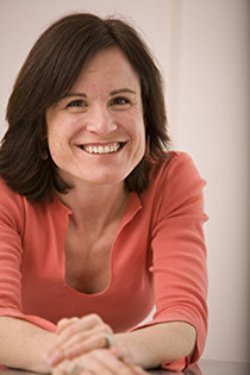Title of the work
Country of the First Edition
Country/countries of popularity
Original Language
First Edition Date
First Edition Details
Joan Holub and Leslie Patricelli, Good Job, Athena! "Mini Myths", New York: Abrams Appleseed books, 2016, 24 pp.
ISBN
Official Website
abramsbooks.com (accessed: July 12, 2018)
Genre
Didactic fiction
Mythological fiction
Picture books
Toddler book*
Target Audience
Children (aged ca 0–4)
Cover

We are still trying to obtain permission for posting the original cover.
Author of the Entry:
Ayelet Peer, Bar-Ilan University, ayelet.peer@gmail.com
Peer-reviewer of the Entry:
Lisa Maurice, Bar-Ilan University, lisa.maurice@biu.ac.il
Susan Deacy, University of Roehampton, s.deacy@roehampton.ac.uk

Photo courtesy of Joan Holub.
Joan Holub
, b. 1956
(Author)
Joan Holub is a prolific children's author from the USA. Graduated from college in Texas with a fine arts degree. Worked as an art director at Scholastic trade books in New York. She has written and/or illustrated over 150 children's books. She has developed a range of series for teenagers on mythological themes: Goddess Girls, set in Mount Olympus Academy, Grimmtastic Tales series, set in Grimm Academy, Thunder Girls, about Norse gods set in Asgard Academy, and Heroes in Training, in which the male Greek gods, as very young men, set out on a range of adventures. For pre-school children, Jan Holub has written on a range of topics including several works with religious and historical themes. These include: This Little President; This Little Trailblazer, Hooray for St. Patrick’s Day!, and Light the Candles: A Hanukkah Lift-the-Flap Book. Joan Holub trained in fine art and worked as an art director at a graphic design company before becoming a children's illustrator and then author.
Sources:
Official website (accessed: July 2, 2018).
Profile at the penguinrandomhouse.com (accessed: July 2, 2018).
Profile at the simonandschuster.com (accessed: July 2, 2018).
Bio prepared by Sonya Nevin, University of Roehampton, sonya.nevin@roehampton.ac.uk and Allison Rosenblum, Bar-Ilan University, allie.rose89@gmail.com and Ayelet Peer, Bar-Ilan University, ayelet.peer@gmail.com
Questionnaire
1. What drew you to writing / working with Classical Antiquity and what challenges did you face in selecting, representing, or adapting particular myths or stories?
I learned to love Greek and Norse mythology in elementary school. I’m very comfortable adapting the framework of an existing myth or fairy tale by pushing it into a different setting, adding humor, and/or building in a nonfiction component. Staying true to the essential core of each myth along the way is important to me. A young Goddess Girls reader once told me she enjoyed the series because she “learned something”. In other words, while she liked being entertained, she appreciated that her familiarity and factual understanding of the original myths was broadened at the same time.
2. Why do you think classical / ancient myths, history, and literature continue to resonate with young audiences?
Kids have questions about their world. So it’s interesting to them to learn how ancient Greeks and other cultures answered questions about how their world worked in exciting tales of heroes and beasts. How did the sun cross the sky? In a chariot drawn by the god Helios. What caused night? The goddess Nyx’s starry cape covered the sky. Thrilling stories of courage and danger, such as Heracles’ twelve labors, the Trojan Horse, and the Argonauts never go out of style.
3. Do you have a background in classical education (Latin or Greek at school or classes at the University?) What sources are you using? Scholarly work? Wikipedia? Are there any books that made an impact on you in this respect?
I have an entire shelf of mythology resource books. Some of my favorite go-to sources are the Scholastic Mythlopedia series, Edith Hamilton’s Mythology, Timeless Tales of Gods and Heroes, and www.theoi.com (accessed: May 28, 2018).
4. How concerned were you with "accuracy" or "fidelity" to the original? (another way of saying that might be – that I think writers are often more "faithful" to originals in adapting its spirit rather than being tied down at the level of detail – is this something you thought about?)
Each book in the Goddess Girls series (ages 8–12, Simon and Schuster) and Heroes in Training series (ages 7–10, Simon and Schuster) is a retelling of one or two Greek myths, with a twist. We stay as true as possible to the core bones of an original myth in order to give young readers a good understanding, but we include kid situations and humor to entertain. As an example, in Goddess Girls #1: Athena the Brain, Athena is summoned to attend Mount Olympus Academy, where Zeus is the principal. MOA teachers include Mr. Cyclops, who teaches Hero-ology, a class where students are graded on their abilities to maneuver small hero figures such as Odysseus, around a gameboard to enact the Trojan War, etc. Meanwhile, Athena, who is the goddess of invention among other things, inadvertently turns mean-girl Medusa’s hair to snakes and gives her the power to turn mortals to stone by means of a shampoo-like invention called Snakeypoo at the MOA invention fair.
5. Are you planning any further forays into classical material?
Suzanne Williams and I have written a new middle grade series called Thunder Girls (accessed: May 28, 2018), which is a twist on Norse mythology featuring strong girl characters. The first book Freya and the Magic Jewel releases May 2018 for ages 8–12, published by Simon and Schuster.
Prepared by Allison Rosenblum, Bar-Ilan University, allie.rose89@gmail.com and Ayelet Peer, Bar-Ilan University, ayelet.peer@gmail.com

Photo courtesy of Leslie Patricelli.
Leslie Patricelli (Illustrator)
Leslie Patricelli is an illustrator based in Hailey, Idaho, USA. Patricelli majored in communications from the University of Washington, and took classes at the School of Visual Concepts in Seattle. She first worked as an advertising copywriter. Her work is primarily aimed at books for a preschool audience and carried out for Candlewick Press. She has recently begun branching out into writing children's literature. She created Rover the dog for Windows XP help.
Sources:
Official website (accessed: January 13, 2018).
Profile at the goodreads.com (accessed: June 26, 2018).
Bio prepared by Allison Rosenblum, Bar-Ilan University, allie.rose89@gmail.com and Sonya Nevin, University of Roehampton, sonya.nevin@roehampton.ac.uk
Summary
Little Athena is a master in tying shoes. But one day another girl asks her to tie a bow for her and then takes the credit for it in front of the other children. What will Athena do?
Analysis
The Mini Myths series is aimed at bringing mythological tales or moral into a more familiar setting for the young readers, so they can understand the story. Here the mythological story which influenced the book is Athena’s rivalry with Arachne. The narrated story is less dramatic than the mythological contest and revolves around tying bows. The rivalry is not so stressed and it is insinuated from Athena’s facial expressions and from the other girls’ boasting that her bows are the best. The ending is very different since Athena helps the girl again and the girl admits her wrongdoing – so no one turns into anything unnatural. It seems as if the modern adaptation misses the mythological tales. After all, Arachne was punished because she dared boasting and showing disrespect to the gods, hardly similar to bow-tying. Furthermore, there is no real moral in the original myth and Arachne never given the chance to admit her mistake.


